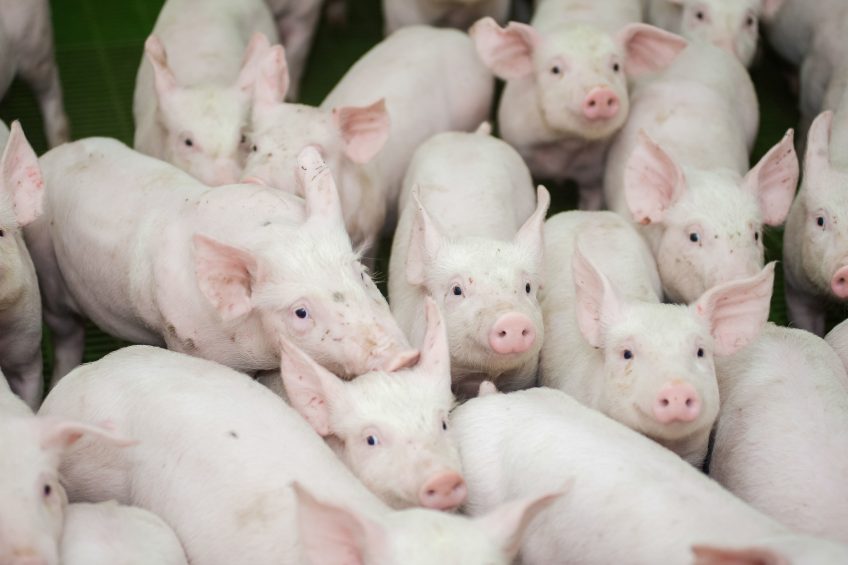A better gut health starts with a functioning stomach

A proper functioning of the stomach is essential to promote piglet health. The stomach has a huge influence on protein digestion and is the first barrier to prevent bacterial infections. The functioning of the stomach is influenced by the nutritional composition of piglet feed.
Undigested proteins put a high pressure on the intestinal health of piglets. This is because it is fermented by pathogenic bacteria and converted into ammonia and amines, which harm the gut barrier function. On its turn this favours the passage of toxins, bacteria and antigens through the intestinal barrier.
For this reason, a lot of well-digestible protein sources are used in piglets, like e.g. dairy protein, potato protein or soya protein concentrates. However, other nutritional measures can also be taken to improve protein digestion in the stomach.
For a proper protein digestion, the functioning of the stomach is essential. In the stomach, proteins are being digested by pepsin. Pepsin is only able to function at a low stomach pH, which is often a problem in young piglets. Piglets are only able to produce limited amounts of hydrochloric acid (HCl) in the stomach, which limits stomach acidification and protein digestion. HCl plays an important role in gastric juice.
Firstly, hydrochloric acid facilitates protein digestion. HCl denaturates dietary proteins, exposing peptide bonds to proteolytic enzymes. In addition, HCl activates pepsinogens to pepsin and provides a medium of low pH that ensures optimal activity of the pepsin enzyme.
Gastric acid secretion
It is not until the age of seven to ten weeks that the gastric acid secretion by the parietal cells is fully developed. For that reason, piglet diets are often supplemented with high amounts of organic acids. That, however, is only part of the solution. Too many organic acids can have a negative effect on feed intake.
For that reason, it is important to keep the acid binding capacity of the feed at low levels. In this way, the limited amount of acid produced by the piglet itself will not be buffered by the feed, resulting in an improved protein digestion. Because of the high acid binding capacity of the mineral fraction of the feed (see Figure 1), a carefully balanced mineral composition of the feed is essential to support adequate protein digestion.
Figure 1 – Acid binding capacity of different raw materials.

Another interesting approach to increase protein digestion, is to increase the protein’s retention time in the stomach. The time it takes for the digesta to travel through the gut varies with the animal’s age and diet. The younger the animal, the faster the digesta leave the stomach. It has been shown that an increased retention time of protein in the stomach improves protein digestion. Several raw materials have been shown to increase the retention time of the feed in the stomach: for instance, an elevated fibre level, high fat levels, extruded cereals and organic acids are known to influence the retention time.
Pathogen kill-off
An acidic environment alone is often not sufficient for a smooth kill-off of pathogenic bacteria entering the stomach. An acid environment is often bacteriostatic, but not always bactericidal. The use of free and activated medium-chain fatty acids (MCFA) on the other hand has been proven to increase the antibacterial effect early in the stomach. MCFA are saturated fatty acids consisting of aliphatic tails of total chain length of either 6 (caproic acid), 8 (caprylic acid), 10 (capric acid) or 12 (lauric acid) carbon atoms and a polar head. As these medium chain fatty acids have a hydrophilic-lipophilic balance that closely resembles the hydrophilic-lipophilic balance of the bacterial cell membrane, they are very efficient in destabilising this membrane. This results in the lowest minimal inhibitory concentrations of all acids known.
In this way, the function of the stomach as an antibacterial barrier can be enforced. This is a very efficient way, as the low pH of the stomach puts bacteria at their most vulnerable place to be attacked.
It is important to note that it is essential to use free MCFA as when they are esterified, they become only gradually active in the intestinal tract after endogenous lipase releases the free MCFA molecules. MCFA prove to be an early barrier, significantly altering the balance between pathogenic and beneficial bacteria in the later stages of the intestine (see Figure 2).
Figure 2 – Number of Enterobacteriaceae and Lactobacilli in the ileum of piglets after the addition of Medium Chain Fatty Acids* (MCFA) to the feed.
Reducing epithelial cell death
The beneficial microbial ecosystem reduces pathogen-induced intestinal epithelial cell death and an increased villus height. This means less renewal of epithelial villi cells is necessary, meaning a sparing of energy for growth of the animal. An increased villus height is also related to more fully mature enterocytes. Therefore, the increase in villus/crypt ratio that is accomplished by MCFA favours the digestive and absorptive capacities of the small intestine.
Increasing the functionality of the stomach of piglets is essential to improve piglet health and performances after weaning. By using different nutritional strategies, this first important step in protein digestion and antibacterial function can be improved.












